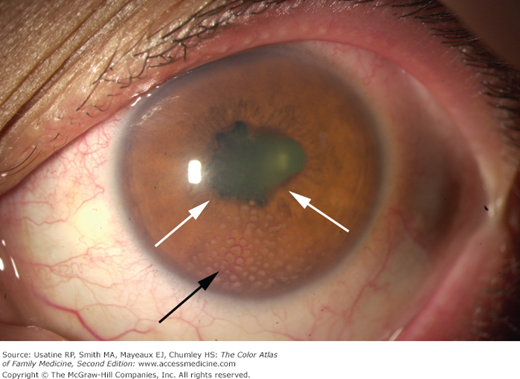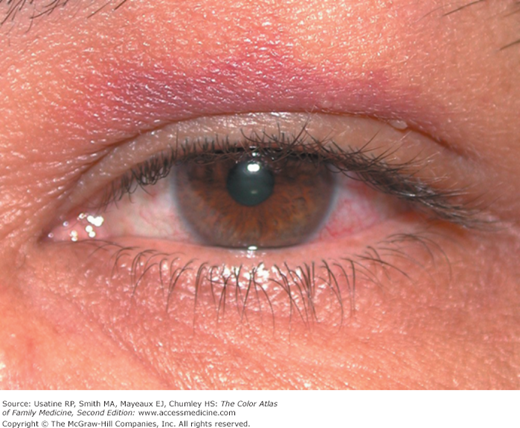Patient Story
A 28-year-old man presented with sudden onset of a right red eye, severe eye pain, tearing, photophobia, and decreased vision. He denied eye trauma. His review of systems was positive for lower back pain and stiffness over the past year. On examination, he had a ciliary flush (Figure 18-1) and decreased vision. He was referred to an ophthalmologist who confirmed the diagnosis of acute anterior uveitis. He was found to be HLA-B27 positive with characteristics of ankylosing spondylitis. His uveitis was treated with topical steroids.
Introduction
Uveitis is inflammation of any component of the uveal tract: iris (anterior), ciliary body (intermediate), or choroid (posterior). Most uveitis is anterior and is also called iritis. Uveitis is caused by trauma, inflammation, or infection and the most common etiologies vary by location in the uveal tract. Patients present with vision changes and, if uveitis is anterior, eye pain, redness, tearing, and photophobia. All patients with uveitis should be referred to an ophthalmologist.
Synonyms
Epidemiology
- Annual incidence of uveitis is 17 to 52 per 100,000 population and prevalence is 38 to 714 per 100,000 population.1
- Occurs at any age, but most commonly between 20 and 59 years.1
- Anterior uveitis (iritis) accounts for approximately 90% of uveitis as seen in primary care settings.1
- Eighty percent of uveitis cases seen in children are caused by juvenile rheumatoid arthritis.2
- In the United States, noninfectious uveitis accounts for 10% of legal blindness.3
Etiology and Pathophysiology
- Uveitis can be caused by trauma, infections, inflammation, or, rarely, neoplasms. Most likely causes differ by location.4
- Iritis—Trauma is common (Figure 18-2). In nontraumatic cases, causes include idiopathic (50%); seronegative spondyloarthropathies, that is, ankylosing spondylitis, reactive arthritis, psoriatic arthritis, inflammatory bowel disease (20%); and juvenile idiopathic arthritis (10%). Infections are less common and include herpes, syphilis, and tuberculosis.4
- Intermediate—Most are idiopathic4 (Figure 18-3).
- Posterior—Toxoplasmosis is the most common, followed by idiopathic.4
- Panuveitis (affecting all layers)—Idiopathic (22% to 45%) and sarcoidosis (14% to 28%).4 Unilateral panuveitis is often endophthalmitis (endogenous or related to trauma or surgery). Bilateral panuveitis can be caused by sarcoidosis or syphilis.





